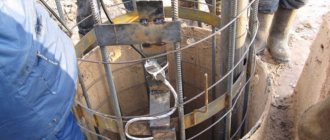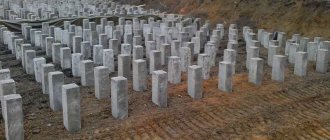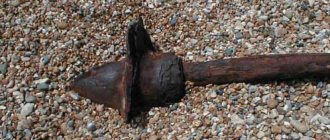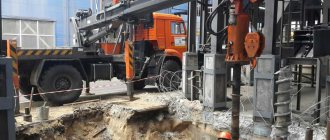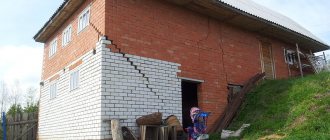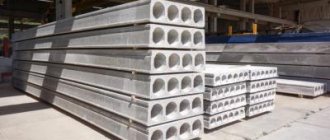INSTALLATION OF BORED PILES (BNS) IN CASING PIPE
When constructing objects in megacities with high building density, the optimal solution would be to install bored piles using casing pipes.
This technology has a number of advantages and is suitable for various types of buildings. offers services for the construction of foundations and foundations for structures using this technology.
The work is carried out using a modern fleet of special equipment and high-quality building materials, which guarantees the reliability of the entire facility.
Installation of bored piles - technology
The method of installing bored piles is used depending on the various conditions under which construction is carried out, as well as depending on economic feasibility. An equally important role is played by the capabilities of the equipment and techniques that the builders used.
This technology has been widely used and known for a long time, but previously it was used only in the design of complex industrial structures.
The essence of this method is that using a special installation, holes of the required sizes are drilled, after which a reinforcement cage is immersed into the finished well, which is then filled with a concrete solution. It is also necessary to leave the reinforcement protruding above the surface - this will ensure a strong connection with further structures.
The nuances of installing bored piles without casing pipes
When installing bored piles, the type of soil should be taken into account, because the base of such piles can ultimately be made in one of two ways - with or without the use of extractable casing pipes.
Bored piles, which are made without the use of casing pipes, are usually made like this: a well is drilled in the ground using one of the drilling methods - impact or rotary.
During this process, a clay solution is used to compress the walls of the well, which helps prevent the possibility of collapse. In addition, particles of drilled soil will be carried to the surface due to the upward flow of the solution.
Then a reinforcement frame is immersed in the finished well, which can be installed in several ways: along part of the length of the pile, along the entire length of the pile, or at the very top of the pile so that it can be connected to the grillage. Find out how piles are drilled in water-saturated soils.
Further actions when installing bored piles
Next, the well must be concreted using a pipe that is gradually moved upward, and it is necessary to ensure that when lifting the concrete pipe during the concreting process, its lower end is firmly buried at least one meter into the concrete mixture.
The concrete mixture fed into the pipe is compacted using a vibrator that is attached to the concrete pipe. Another concreting method can be called a method based on the use of a mixer with a concrete pump.
It is capable of pumping concrete into the well, leaving the concrete pipe in a static position, and it is removed only when concreting is completed. This sequence during concreting eliminates the possibility of the pile being compressed by soil in the future, which will ensure excellent quality of the concrete coating.
Installation of bored piles using casing pipes
If bored piles were made using so-called casing pipes, then they are made according to the following scheme: first, a well is drilled where a pile-pipe frame is installed. At the same time, the casing pipe allows you to cover the horizons of quicksand soils lying at depth, guarantees safety when carrying out any piling work and helps to control the main parameters of the borehole. As a result, the well is filled with high-quality concrete solution.
This technology makes it possible to produce piles that will have a widening of up to 120 cm, which makes it possible to use the full bearing capacity of the entire supporting thickness of the soil at the base, increasing the efficiency of using bored piles.
Advantages of installing bored piles
- There is minimal negative impact on surrounding structures. Thanks to this, such technology can be used in difficult geological conditions or in densely built-up conditions of modern cities.
- The noise level is extremely low, and this allows you to work day or night without causing significant discomfort to others.
- The ability to withstand loads is extremely high. Such a foundation can support a building up to 250 meters in height.
Read also: How to drill a hole in stainless steel
This technology will reduce the sometimes protracted construction time, which, undoubtedly, can be called a real bonus for both the customer and the construction team.
The process of installing bored piles involves drilling holes, placing reinforcement and pouring concrete. When driving such a pile there are no vibrations. This determines the main area of application - cities and areas with dense buildings, where vibrations could damage nearby structures.
Other conditions under which bored piles are preferred:
- wetlands, weak soils where incompressible layers lie deep. In such cases, the production of bored piles is carried out using casing pipes;
- due to its high load-bearing capacity - during the construction of heavy structures and industrial structures;
- when building on steep terrain.
For light wooden houses and frame buildings, such a foundation is not economically feasible.
IN WHAT CASES IS THIS TECHNOLOGY USED?
- Construction in densely built-up areas.
- Construction and installation work in old areas of cities where impact technologies pose a danger to existing structures.
- Construction of particularly large objects that require large loads on the foundation.
- Construction of objects on soils in which the low-compressible layer lies quite deep.
- Work in difficult geological conditions.
- The construction of foundations made of reinforced concrete bored piles is used in cases where any vibrations are excluded in order to avoid deformation of nearby objects or in areas where vibrations and impact technologies can lead to soil displacement.
Features of bored piles for a cottage
“Bored piles for foundations” - starting from the name itself, you can already imagine the design features of such a foundation. Bored foundations consist of the following elements: bored piles and grillage. In essence, such a foundation is a pile foundation. The only difference is that the piles are not driven into the ground, but are installed in special wells.
A bored pile is an element created by hand, which makes it possible to comply with the following requirements: the optimal indicator of the area where the soil and foundation come into contact, with the latter having a minimal lateral surface. This is due to the piles themselves, which are installed at great depths in the ground and are characteristically round in cross-section. The foundation is reliable and accessible.
The main task of the reinforcement cage is to strengthen the piles, but it also performs other functions. Using reinforcement, it is possible to provide a connection between the foundation and the iron grillage. This means that the above-ground and underground parts of the house will be connected to each other into one whole. In addition, the reinforcement cage plays another important role: it protects the foundation when the soil heaves under the influence of frost.
The pile is filled with concrete in layers and compacted by bayoneting. When filling pile holes, as a rule, “heavy” grades of concrete are used. The word “heavy” refers to that type of concrete, the filler of which is gravel, crushed stone or quartz sand (in a word, durable rock).
Filling piles with concrete should be carried out in a continuous mode, that is, for laying individual portions of concrete, an interval of no more than an hour should be maintained. The load for such a foundation is permissible only when the concrete has completely set.
In the process of low-rise construction, as well as in cases where it is necessary to build a house made of brick, soil-cement piles are often used. This is a resource-saving and constantly improving technology. It was developed specifically for low-rise construction. These piles are relevant when it is necessary to build a foundation in unwatered, stable soil. The piles themselves used in this technology are distinguished by the fact that the least amount of materials and manual labor is required during the process of concreting a well.
Bored piles with widening
GOST for bored piles, which we follow
Estimate for installation of bored piles
COST OF WORK (WITHOUT MATERIALS) FOR CONSTRUCTING BORED PILES (BNS) FOR 1 M3 (RUB, excluding VAT):
| soil category | pile diameter, mm | |||||
| F620 | F750 | F880 | F1000 | F1200 | F1500 | |
| 1cat | 12000 | 11000 | 10000 | 8000 | 7000 | 6000 |
| 2cat | 16000 | 14000 | 12000 | 10000 | 8000 | 7000 |
| 3cat | 18000 | 15000 | 13000 | 11000 | 10000 | 8000 |
| 4cat | 23000 | 20000 | 18000 | 16000 | 14000 | 13000 |
| 5cat | 28000 | 25000 | 23000 | 20000 | 18000 | 17000 |
| 6cat | 38000 | 34000 | 31000 | 28000 | 24000 | 23000 |
ADVANTAGES OF TECHNOLOGY
The main advantage of this method of foundation construction is the absence of vibration and dynamic vibration of the soil and, as a result, a negative impact on surrounding objects. Other advantages include:
- Significant reduction in time for foundation installation.
- High-quality work.
- High load-bearing capacity.
- Possibility of making piles of any length.
- Low cost of installation of bored piles.
The advantage of technology using bored piles
Casing pipe is a reliable way to strengthen the soil wall in the holes being formed. Pipes for bored piles consist of rigidly connected sections. The use of this technology in practice is effective not only on problematic soils, but also when developing buildings in metropolitan areas on a small area. The speed of processing and the cost of installation depends on the main factors:
- general condition of drilling equipment;
- diameter and depth of the well;
- soil type.
The principle of the technology for installing bored piles with casing is quite simple. When forming deep rods, a drill shaft is formed step by step with pipes interlocking one after another. It is important to tightly fix the casing (from any material) as you move deeper.
- Drilling equipment is installed at the prepared site, which makes wells of the designed width and depth.
- Plastic or metal casing pipes for bored piles are buried using a screw-in shaft pipe. The required level is fixed in advance in the design documentation.
- Fragments of pipes are interconnected in the same way as is provided for products made of one or another material, the so-called “advanced penetration”.
- When the drill column is fully formed, the soil that crumbled during the formation of the hole is removed.
- A frame made of reinforcement under the piles is inserted into the prepared shaft.
- The prepared cement-sand mixture is supplied in portions through a concrete pipe (piling).
- The casing is removed from the well section by section.
Cement-sand mixture is poured into the prepared well in small portions
Advantages of safe technology for inserting bored piles with casing:
- the ability to work near nearby structures, due to the absence of shock and vibration processes during excavation;
- work in difficult soils (floating, water-saturated, weak and crumbling, saline);
- guarantee of perfect vertical alignment and 100% drilling quality;
- high productivity of drilling equipment,
- possibility of deep work with overlapping horizons;
- safety of piling work;
- 100% protection of well shafts from collapse and control of all stages of the process;
- protection of the drilling shaft from groundwater;
- saving concrete with efficient pouring (without necks);
- minimizing the number of miscalculations during installation;
- drilling, widening, extraction of boulders and large fractions when working with a drill;
- control of compliance of design parameters with practical work;
- the maximum possible load-bearing functionality of the well due to a high-quality wall.
One of the types of casing pipes are plastic products. Polymer parts are produced for different purposes from the following types of materials:
- LDPE – high-density polyethylene;
- HDPE – low-density polyethylene;
- PNP – low density polyethylene;
- PVC – polyvinyl chloride.
The wall thickness of the casing pipes varies within 40mm. These products have many advantages:
- sufficient tightness of the connection;
- absence of corrosion processes;
- low cost relative to metal products;
- light weight;
- high resistance to chemical or other aggressive environments;
- accelerated installation due to simple connection of casing cylinder sections.
Polymer casing pipes can only be used for constructing domestic water wells
The only negative is that plastic casing pipes are not very strong, which is why it is easy to destroy their integrity with a sharp blow with a sharp tool and they are not suitable as casing with BNS. These products are preferred to be used because of their low cost and practicality for drilling domestic wells for water supply to private households.
FEATURES OF BNS TECHNOLOGY
In the standard design using pipes, they are immersed in the hole being drilled simultaneously with the excavation of soil. Thus, the pipe fits tightly to the walls of the hole, preventing the soil from shedding and deforming. After the hole is drilled to a given depth, a reinforcement cage made of welded metal is immersed into it, and then concrete is poured.
Depending on which bored pile installation is used, soil excavation can be carried out without the use of pipes. Thus, Stroy-Partner offers an innovative technology that is widely used in construction in the USA and Europe: a continuous hollow auger. When using this technology, soil excavation is carried out using a column consisting of hollow augers. The soil is lifted to the surface by spiral winding on an auger. This technology has the following advantages:
- Lower noise level, which allows the equipment to be used even in densely populated areas.
- High performance.
- High load-bearing capacity of structures.
- The price for installing bored piles in casing in Moscow and the regions is calculated based on the complexity of the work, the size of the structure, the quantity and type of materials and equipment used.
By contacting Stroy-Partner, you receive prompt implementation of the project with a guarantee of quality. Professionalism and many years of experience in general contracting piling and drilling work in Russia, the use of advanced technologies and our own fleet of high-performance equipment are what distinguishes the company in the market.
Features of bored pile technology
Piles are mounted in this way:
- The well is drilled, after which it is cleared of snow, water, and sludge (a layer of no more than 15 cm is allowed in the remainder);
- Piles are checked for the presence of frozen soil, ice and other fragments;
- Approximately 1/3 of the total depth of the pile, a solution is poured into the well;
- During the first 4 hours after drilling the well, the pile is driven vertically.
The pile squeezes out the solution, which freezes with the soil, and the pile freezes with the solution. The result is a structure ready for further loads.
There is also another technology in which the pile is filled with mortar, and the space behind the wall is filled with soil that is not prone to heaving.
TECHNOLOGY FOR CONSTRUCTION OF BORED PILES
DRILLING A WELL
- Place the drilling and crane rig in the working position, with the center of the working body being installed directly above the upper end of the pile stake. The mast of the drilling and crane rig must be strictly in a vertical position. Make sure that the tool does not interfere with the dimensions of the installation itself.
- Wells are drilled using a rotary method using inventory casing pipes Ø*mm. Drilling wells should be done without advancing the bottom hole relative to the lower end of the casing pipes.
- When pressing the first section of the casing, it is necessary to pay special attention to maintaining its verticality to ensure design tolerances for the deviation of piles from the vertical. The casing pipe is continued to be pressed as long as the soil allows it. Advanced immersion of inventory casing pipes with a reinforced tip (carbide crown) into the ground. The casing pipe is plunged into the ground by reverse rotation to a depth of 2-8 meters. The depth of a single immersion depends on the density of the soil and the groundwater level. When immersing pipes in soft-plastic, water-saturated soils, the depth of a single immersion is determined by the possibility of deepening the lower cut of the pipe, water-resistant clay layers, which prevents the flow of soil into the well when removing soil from the pipes. When immersing inventory pipes, the verticality of their installation is periodically checked using a level or plumb line.
- The incoming soil is removed from the casing pipe using a bucket drill (soft-plastic and fluid soils). In the semi-hard rock excavation zone, an auger drill equipped with rock cutters is used to sample soil, and in the hard rock excavation zone, sampling is carried out with a core drill. Soil sampling should be carried out in short runs (no more than 1.0-1.5 m). When extracting soft-plastic and fluid soils, as well as water-logged filter soils, the length of the trip must be reduced and the lifting speed of the bucket drill must be reduced in order to prevent the entry of soil material through the face into the internal cavity of the casing and to prevent settlement of nearby structures. It is also necessary to ensure that there is an anti-seepage soil plug at the bottom of the well with a height of at least 3 meters from the lower end of the casing. The height of the plug depends on the groundwater level at the site and the nature of the rocks being drilled.
- During the drilling process, build up the casing pipe in sections 2, 3, 4 m long. The sections of casing pipes are connected with special equipment. locks (conical bushings). The connection of casing pipe sections is shown in the diagram below. At all stages of drilling, a soil plug of 40 cm in height must be maintained. The sections of casing pipes must be supplied using a special 2-leg sling with mounting brackets attached to the ends. This sling must not be used for other purposes.
- Before joining sections of casing pipes, their flanges must be cleaned of dirt. The connecting plugs are screwed in such a way that their outer surface is “flush” with the outer surface of the casing. It is prohibited to carry out drilling operations when the plugs are not completely connected.
- Drilling should be carried out to the designed depth. Upon reaching the design mark, clean the bottom of the well from drill cuttings.
- Cleaning the bottom of the well from sludge is carried out with a special bucket drill. Cleaning should be done without load, at low speed of the projectile. The bottom hole is checked visually for the presence of cuttings, then a control measurement of the well is made and recorded in the drilling log. After cleaning the bottom of the well, the bucket drill is removed from the casing pipes, moved to the side and washed away from the cuttings to prevent it from entering the well when removing the casing pipes during concreting. The permissible deviation in the depth of the well should not exceed ±5 cm.
- Advance drilling with subsequent immersion of casing pipes is prohibited.
- During drilling, measure the depth of the well using a depth gauge, periodically checking its readings with the lot. If actual ground conditions differ from the engineering-geological conditions given in the project, drilling operations should be suspended.
- If the soils do not comply with the geological surveys indicated in the working drawings, draw up a report signed by representatives of the Customer, designer's supervision and technical supervision of the Customer.
- To penetrate boulder soils, use pioneer drilling methods with small-diameter drilling tools, cable-rotary impact action, etc.
- Upon completion of drilling, it is necessary to check the compliance of the project with the actual dimensions of the wells, the elevation of their mouth, bottom and location of each well in the plan, and also establish the compliance of the type of foundation soil with the data of engineering geological surveys (if necessary, with the involvement of a geologist).
- Measurements should be carried out using geodetic methods. Measurements of the deviation of the well axis should be carried out in the presence of a commission of representatives of the designer's supervision and technical supervision of the Customer. The drilled well is accepted by the commission with the signatures of the “Act of Inspection of Concealed Works”.
- The soil drilled from the well is transported by a forklift to an intermediate dump or loaded onto dump trucks and transported from the work site to specially equipped sites (landfills).
- The time interval between cleaning the bottom of the well and the start of concreting the well should be no more than 8 hours for unstable soils and 24 hours for stable soils.
CONSTRUCTION AND INSTALLATION OF REINFORCING FRAMEWORKS
- Reinforcement of piles when fencing a pit is constructed using spatial frames with symmetrical working reinforcement.
- Sections of reinforcement cages are manufactured on a specially equipped site (reinforcement shop), transported to the construction site by long vehicles and stored in a specially designated place.
- The enlarged assembly of frames should be carried out in a specially designated place (reinforcement shop) on the construction site with the corresponding entry being made in the welding log. Welding of frame sections is carried out using electrodes. Welding seams are standard, according to GOST 5264-80* and GOST 14098-91. Unspecified and non-standard seams are performed by electric arc welding. The leg of the weld is based on the smallest thickness of the elements being welded.
- Store the finished frames on wooden supports under a canopy or cover with a tarpaulin (waterproof fabric).
- Sections of reinforced frames are supplied with a passport for the finished product, and before installation they are inspected and accepted according to the report by the commission. Before diving into the well, it is necessary to clean and remove rust and oil from the fittings.
- The reinforced frame is lowered into the well using a drilling and crane rig at a time, and the method of slinging, lifting and lowering must prevent the occurrence of deformations in it.
- When lowering the reinforced frame, observe the following conditions: keep the frame from swinging and rotating using flexible hemp rope guys.
- The frame should be lowered in a position that ensures its free passage into the trench with geodetic control of verticality and ensuring the design value of the protective layer between the load-bearing reinforcement and the ground. Temporary mounting spacers located inside the stiffener rings must be removed. All workers must stay out of the danger zone. Move the frame to the place of lowering into the well in a vertical position.
- Slingers use the mounting loops of the reinforced frame to rig the hook of the drilling and crane rig. At the signal from the senior slinger, the driver tightens the sling to ensure that the frame is slinged securely, after which the frame is slowly raised, hung in a vertical position and slowly moved to the well. The slingers hold and guide the frame during the lowering process. If it stops due to misalignment, at the signal of the senior slinger, the driver slightly lifts the frame and the slingers level its position. When the reinforced frame has reached its design position in height in the well, slingers secure it in the foreshaft or casing with pipe sections.
- When manufacturing frames, welding work should be carried out in accordance with design documentation, GOST 14098-91, GOST 10922-90 and RTM 393-94 (NIIZhB GOSSTROYA RF). At low temperatures (below -20°C), welding joints of reinforcement is carried out with preheating with gas burners up to 150°-200°C on both sides of the joint at a distance of 3-4 dH of reinforcement, welding work is performed with a welding current 10-15% higher compared to usual. At negative temperatures (below -5°), welding of joints of reinforcement bars is carried out without interruption, with the exception of the time required to change the electrode and clean up the seam during multilayer welding. If there is a forced long break in welding work, it must be resumed after cleaning the seam from slag from the previous seam and preheating the joint in the above manner.
- The welding area and the welder's workplace must be protected from precipitation and strong winds. At temperatures below -30°, welding work during installation is prohibited. Work may only be carried out in an equipped greenhouse. Welding materials should be supplied to the work site immediately before welding in the kit required for the period of continuous work of the welder, having previously dried them in an oven for drying electrodes in accordance with the manufacturer’s recommendations. At the workplace, store coated electrodes in closed cases to prevent moisture.
Preparation for the construction of bored piles
It is necessary to carry out the following preparatory work:
- before starting drilling, you need to prepare the construction site in accordance with the general construction plan and construction project;
- all engineering and technical personnel must be competent in matters of documentation, including regulations, design and standards;
- the responsibility of the site manager is to control the availability of the necessary documentation authorizing such work, as well as the Customer’s stamp;
- fence the construction site;
- take care of the placement of technological and household premises on the construction site;
- install a signal fence around the work area to prevent unauthorized entry;
- clear the site of unnecessary structures;
- the surveyor service breaks down the axes, checking the top elevation of the site, as well as the slope, before installing the drilling equipment and again after it;
- fill, plan and cover the construction site for installation of the machine with slabs;
- carry out the arrangement of access roads by installing road slabs;
- arrange the area for placement of reinforcement frames and equipment;
- take care of the drainage of technical water;
- with the participation of the Customer, determine the choice of sites for temporary placement of landslides;
- Provide lighting of the area for work to be carried out around the clock.
Drilling process
Drilling for piles is carried out using drilling rigs; it involves:
- placement of equipment with re-checking the slope;
- realignment of the swing mechanism, lifting and hitting the axle, tied to the contour fasteners;
- slinging the lower part of the knife section of the pipe, crimping and straightening the section in a vertical position, then slinging its knife part;
- placing the casing pipe in part of the knife section, setting the direction of the entire pipe with further extraction of the soil by an auger or grab into the dump until removal from the site;
- carrying out drilling operations in accordance with the type of soil;
- in soils with watering and instability, water loading is necessary;
- installation of the next segment after reaching the top mark of the pipe connection half a meter above the top of the rocking mechanism of the machine;
- installing and tightening bolts;
- control of the level of lowering of the casing pipe into the ground, the soil in it, groundwater, the thickness and nature of the layers;
- immersion of the pipe to a certain level according to the project;
- checking actual well parameters;
- face cleaning.
There should be a gap of no more than eight hours from the start of clearing to the start of concreting work. If there is a significant delay in the start of installation and concreting, drilling operations should be stopped 1-2 meters before the bottom hole mark according to the project. In addition, the operating pressure in the hydraulic system should be constantly monitored.
CONCRECTING A WELL
- Concreting of bored piles is carried out using the vertically moving pipe (VPT) method using plastic concrete of class *. Before starting concreting a lot, check the bottom of the well. If the depth of the well turns out to be less than that measured after completion of drilling, then use a bucket drill to additionally clean the bottom of the well.
- Preparing a well for concreting includes:
— measuring and recording the well bottom mark in the journal;
— preparation of slings for moving links of concrete and casing pipes;
— installation of the casing table (if necessary) with a crane on the casing pipe;
— assembly of concrete pipe links with an internal diameter of 245 mm. The bottom of the concrete pipe should be 30-50 cm above the bottom of the well. The joints of the concrete pipe links must be sealed.
- Begin concreting after filling the receiving funnel with concrete mixture.
- Breaks in concreting the pile, with the exception of technological breaks of up to 20-30 minutes, are not allowed, because lead to the formation of defects.
- After feeding the concrete mixture into the concrete pipe, measure the distance from the top of the casing to the concrete surface. If the distance from the bottom of the casing pipe to the surface of the concrete mixture is more than 8.0 m, then the upper element (4.0 m) of the casing pipe should be dismantled.
- When dismantling a concrete pipe, it must be taken into account that its lower end rises by the length of the elements being removed and also temporarily by 1.0 m (for two-meter elements). In this case, it is necessary that the lower end is constantly buried in the concrete mixture.
- When concreting the well is completed, it is necessary to remove the contaminated layer of concrete mixture. Measure the filling level and, if necessary, bring the top of the pile to the level of the design mark. In this case, it is allowed to use dosed feed from a concrete mixer truck.
- Emergency situations:
— when concreting is delayed, the casing string must be periodically rotated to avoid the pipe surface from sticking to the hardening material
concrete mixture;
- remove clogging of the concrete pipe by shaking it;
- if the blockage of the pipe is not eliminated, as well as if water breaks through
- concrete pipe through the bottom of the pipe due to its being pulled out of the concrete mixture, the concrete pipe should be removed and washed. Dismantle the column of casing pipe links remaining in the well or raise the casing table so that the level of the concrete mixture in the well is 2.0-2.5 m above the teeth of the knife bit. Then lower the drilling tool onto the surface of the concrete and drill it to a depth of 1.0 m. After this, lower the concrete pipe so that its bottom is 30 cm above the teeth of the knife bit, and then concrete the remaining part of the well.
- All operations for concreting a pile must be reflected in the “Concrete Work Log”, filled out at the construction site, as well as in the “Concealed Work Report”. The Contractor transfers them to the Customer upon delivery of the as-built documentation.
FEATURES OF WORK PRODUCTION AT NEGATIVE ENVIRONMENT TEMPERATURES
- In winter conditions, in addition to the general requirements stated above, additional control is carried out.
- During the preparation of the concrete mixture, control is carried out at least every 2 hours:
— absence of ice, snow and frozen lumps in unheated aggregates supplied to the concrete mixer when preparing a concrete mixture with antifreeze additives;
— temperature of water and aggregates before loading into the concrete mixer;
— concentration of the salt solution;
— temperature of the mixture at the outlet of the concrete mixer.
- The duration of transportation of the concrete mixture should ensure that the temperature of the concrete mixture does not drop below + 10°C. When transporting concrete mixtures, once a shift the implementation of measures for covering, insulating and heating the transport and receiving containers is checked.
- Use concrete with antifreeze additives and hardening accelerators in accordance with the design documentation.
- When laying the mixture, its temperature is monitored during unloading from vehicles and the temperature of the laid concrete mixture.
- The temperature of concrete is measured by remote methods using temperature wells, resistance thermometers, or technical thermometers are used.
- When the air temperature is below minus 25°C, concreting piles is prohibited.
- Before lowering the frames into the pile, they must be cleared of snow and ice.
- Maintenance of concrete pile heads is carried out using a heat-moisture protective coating in 3 layers (1. Covering the surfaces of structures made of monolithic concrete with polyethylene film. 2. Covering the surfaces of structures with Dornit cloth over a polyethylene film. 3. Coating the surfaces of structures with polyethylene film over a layer of Dornit for protection from precipitation).
